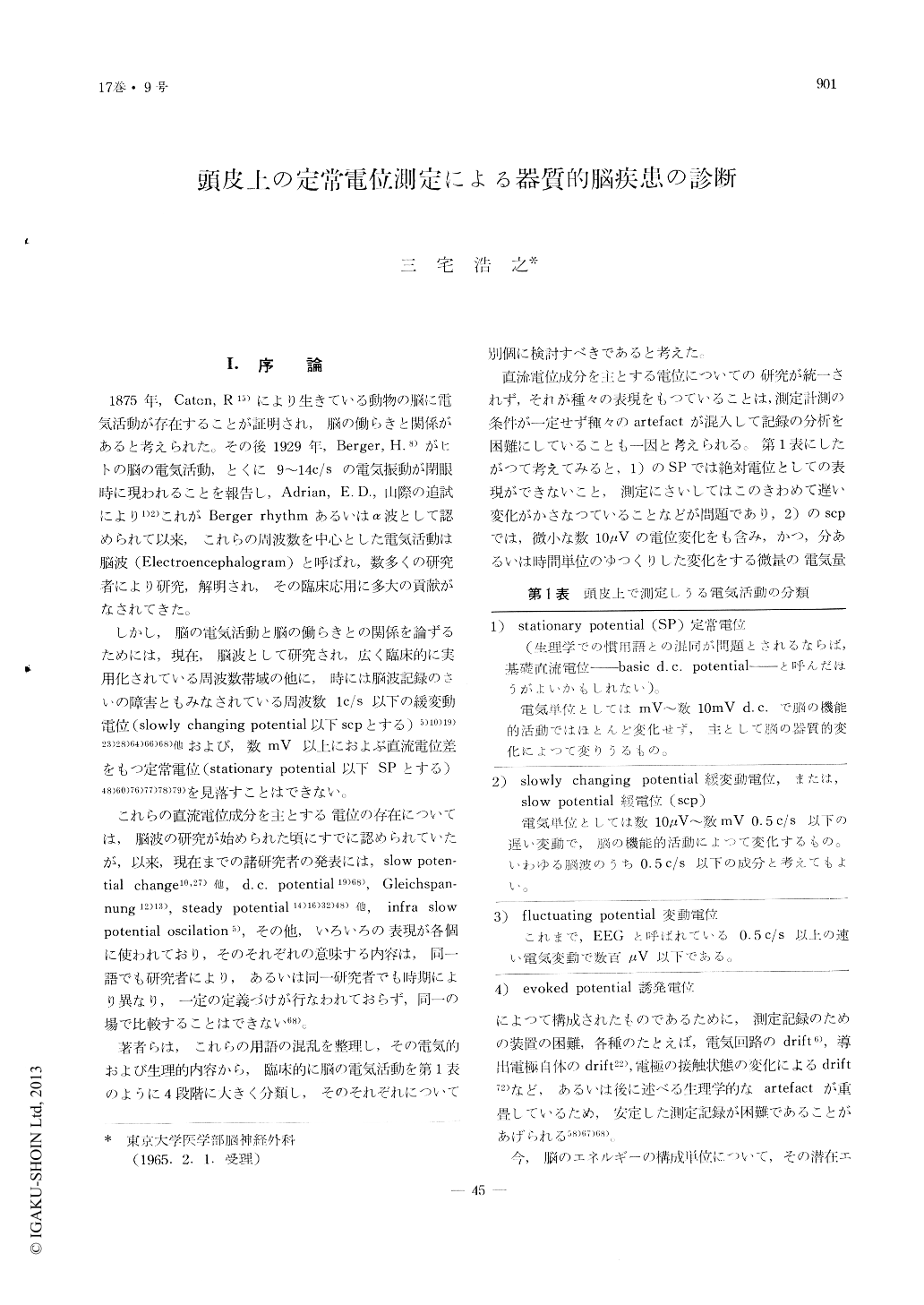Japanese
English
- 有料閲覧
- Abstract 文献概要
- 1ページ目 Look Inside
I.序論
1875年,Caton, R15)により生きている動物の脳に電気活動が存在することが証明され,脳の働らきと関係があると考えられた。その後1929年,Berger, H.8)がヒトの脳の電気活動,とくに9〜14c/sの電気振動が閉眼時に現われることを報告し,Adrian, E. D.,山際の追試により1)2)これがBerger rhythmあるいはα波として認められて以来,これらの周波数を中心とした電気活動は脳波(Electroencephalogram)と呼ばれ,数多くの研究者により研究,解明され,その臨床応用に多大の貢献がなされてきた。
しかし,脳の電気活動と脳の働らきとの関係を論ずるためには,現在,脳波として研究され,広く臨床的に実用化されている周波数帯域の他に,時には脳波記録のさいの障害ともみなされている周波数1c/s以下の緩変動電位(slowly changing Potential以下scpとする)5)10)19)23)28)64)66)68)他および,数mV以上におよぶ直流電位差をもつ定常電位(stationary potential以下SPとする)48)60)76)77)78)79)を見落すことはできない。
The study of the slowly changing electric phe-nomenon and stationary electric potential distribution of the brain (so called steady potentials) is lagging behind the remarkable development of the study of the fast electrical phenomenon such as electroen-cephalography, evoked potentials and so on. But the study of these d. c. components of the brain electric-ity must be very important to establish the theory of the complete electrical brain functions and its mechanisms.
The authors, therefore, described and discussed the stationary electric potential distribution of the brain, that had various sorts of organic lesions. These distributions were measured on the scalp in more than 100 cases with specially prepared and controlled method by excluding many artefacts and noises. (fig. 6) The distribution of the stationary electric potentials of the brain with organic lesion is intimately related to the portion and nature of the lesion. (tab. 3-8) Considering the latent reserved brain energy, the potentials of the brain must be reserved in positive charge to the absolute zero potential (fig. 22), but in the portion of the organic cerebral lesion, the potential is lowered and the dirtribution map of the potentials shows the dip or valley on that location of the brain.
More fine descriptions of the difference of the potential distributions are as follows:--The dis-tinctly localized lesions such as meningioma or re-latively benign gliomas show crater-like pattern, that is, just above the tumor the potential is lower and on the surroundings of the tumor, higher than other parts. (fig. 9)
The diffusely infiltrated lesions such as relatively malignant gliomas show the valley-like or cone-shaped lower potential in the higher potential plateau. (fig. 12)
These phenomenon will be explained well as the summary of the membrane potentials of the cells that composed the cortex of the brain. In the organic cerebral lesion these cell's constructions are destroyed and the sauces of the potentials are dis-appered partially or completely. These will be the reasons that give rise to the differences of the dis-tribution of the potential and the lower potential on the lesion. (fig. 24)
These facts of the potential distribution will be very useful for clinical application of the stationary potential encephalography in organic cerebral lesions
The stationary potentials are measured so quickly and harmlessly, and the data is useful to determine the clinical diagnosis and neurosurgical approach of organic cerebral lesions.

Copyright © 1965, Igaku-Shoin Ltd. All rights reserved.


